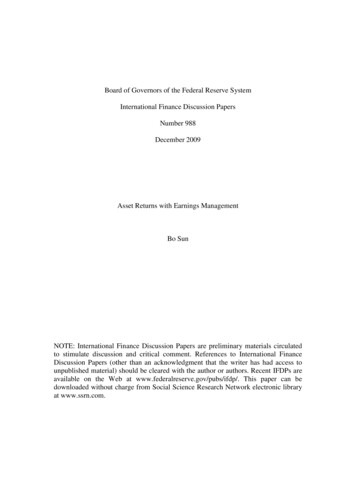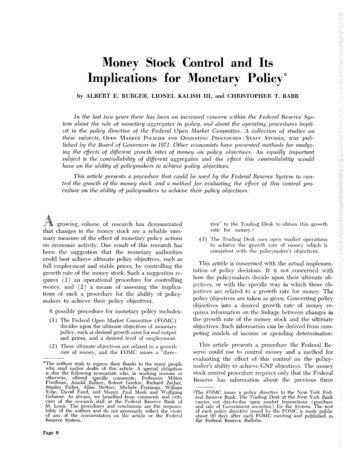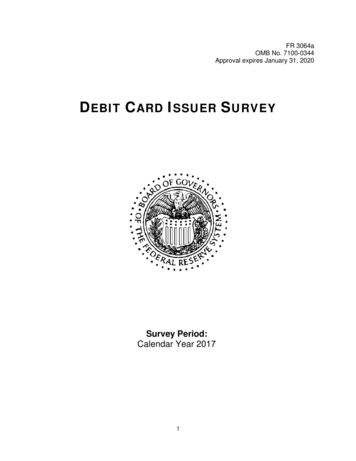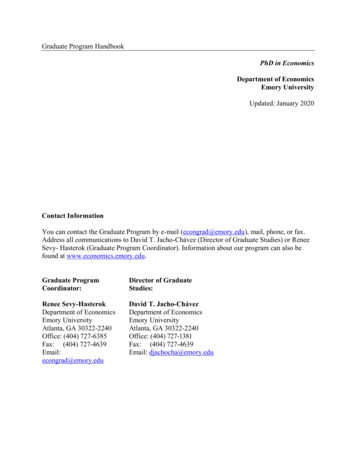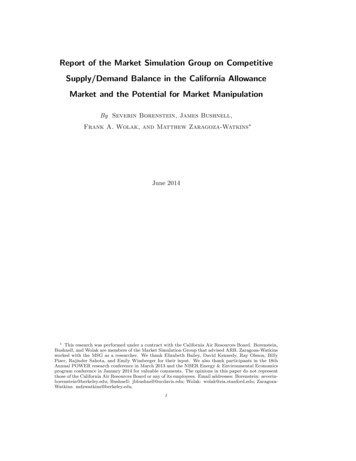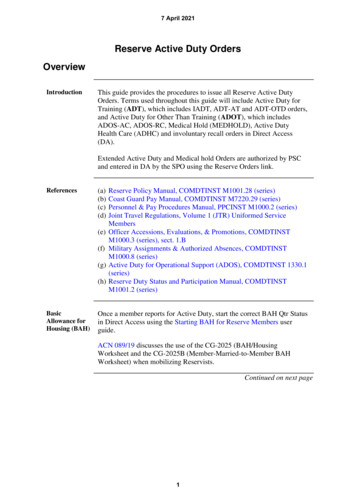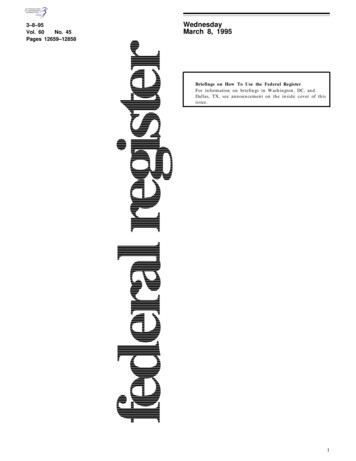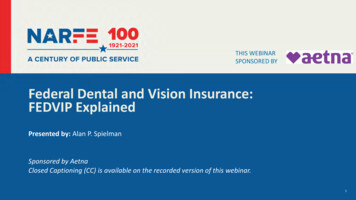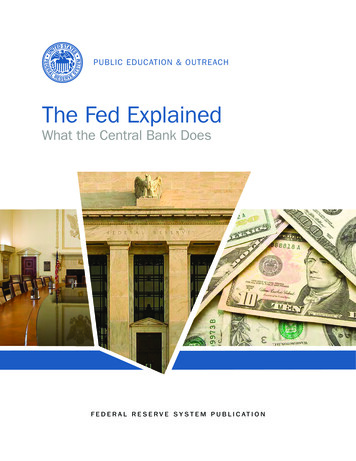
Transcription
PUBLIC EDUCATION & OUTREACHThe Fed ExplainedWhat the Central Bank DoesF E D E R A L R E S E R V E S Y S T E M P U B L I C AT I O N
PUBLIC EDUCATION & OUTREACHThe Fed ExplainedWhat the Central Bank DoesF E D E R A L R E S E R V E S Y S T E M P U B L I C AT I O N
First Edition, May 1939Second Edition, November 1947Third Edition, April 1954Fourth Edition, February 1961Fifth Edition, December 1963Sixth Edition, September 1974Seventh Edition, December 1984Eighth Edition, December 1994Ninth Edition, June 2005Tenth Edition, October 2016Eleventh Edition, August 2021ISSN: 0199-9729DOI: 10.17016/0199-9729.11This and other Federal Reserve publications are availableonline in the Publications section of the Federal ReserveBoard’s website, https://www.federalreserve.gov. To ordercopies of publications available in print, access the FederalReserve System Publication Order Form or contact:Publications Fulfillment(email) Publications-BOG@frb.gov(ph) 202-452-3245(fax) 202-728-5886(mail) Mail Stop N-127Board of Governors of the Federal Reserve System20th Street and Constitution Avenue, NWWashington, DC 20551
Contents1 Overview of the Federal Reserve System. . . . . . . . . . . . . . . . . . . . . . . . . . . . .viThe U .S . Approach to Central Banking . . . . . . . . . . . . . . . . . . . . . . . . . . . . . . . . . . . . .2The Decentralized System Structure and Its Philosophy . . . . . . . . . . . . . . . . . . . . . . . .3The Reserve Banks: A Blend of Private and Governmental Characteristics . . . . . . . . . . .42 The Three Key System Entities . . . . . . . . . . . . . . . . . . . . . . . . . . . . . . . . . . . . . .6The Federal Reserve Board: Selection and Function . . . . . . . . . . . . . . . . . . . . . . . . . . .7The Federal Reserve Banks: Structure and Function . . . . . . . . . . . . . . . . . . . . . . . . . . .8The Federal Open Market Committee: Selection and Function . . . . . . . . . . . . . . . . . . . . 12Other Significant Entities Contributing to Federal Reserve Functions . . . . . . . . . . . . . . . 133 Conducting Monetary Policy . . . . . . . . . . . . . . . . . . . . . . . . . . . . . . . . . . . . . . . .16The Federal Reserve’s Monetary Policy Mandate and Strategy and Why It Matters . . . . . 21The Conduct of Monetary Policy . . . . . . . . . . . . . . . . . . . . . . . . . . . . . . . . . . . . . . . . . 24Monetary Policy Tools . . . . . . . . . . . . . . . . . . . . . . . . . . . . . . . . . . . . . . . . . . . . . . . . 34How Monetary Policy Is Implemented . . . . . . . . . . . . . . . . . . . . . . . . . . . . . . . . . . . . . 394 Promoting Financial System Stability. . . . . . . . . . . . . . . . . . . . . . . . . . . . . . . . 46What Is Financial Stability? . . . . . . . . . . . . . . . . . . . . . . . . . . . . . . . . . . . . . . . . . . . . 47Monitoring Risk across the Financial System . . . . . . . . . . . . . . . . . . . . . . . . . . . . . . . . 48Macroprudential Supervision and Regulation of Large, Complex Financial Institutions . . . 55Domestic and International Cooperation and Coordination . . . . . . . . . . . . . . . . . . . . . . 575 Supervising and Regulating Financial Institutions and Activities . . . . . . . . .62Overview of the Federal Reserve’s Financial Institution Oversight . . . . . . . . . . . . . . . . . 63How the Federal Reserve Supervises Financial Institutions . . . . . . . . . . . . . . . . . . . . . . 69How the Federal Reserve Regulates Financial Institutions . . . . . . . . . . . . . . . . . . . . . . 756 Fostering Payment and Settlement System Safety and Efficiency . . . . . . . .84Overview of Key Federal Reserve Payment System Functions . . . . . . . . . . . . . . . . . . . . 86Providing Services to Banks and the Federal Government . . . . . . . . . . . . . . . . . . . . . . . 86The U .S . Payment System Today and Reserve Bank Services . . . . . . . . . . . . . . . . . . . . 88Regulating and Supervising the Payment System . . . . . . . . . . . . . . . . . . . . . . . . . . . . . 104Providing Banking System Liquidity . . . . . . . . . . . . . . . . . . . . . . . . . . . . . . . . . . . . . . . 108Exploring and Implementing Payment System Improvements . . . . . . . . . . . . . . . . . . . . . 109
7 Promoting Consumer Protection and Community Development . . . . . . . . . . 112Consumer Protection Supervision and Examination . . . . . . . . . . . . . . . . . . . . . . . . . . . 114Administering Consumer Laws and Drafting Regulations . . . . . . . . . . . . . . . . . . . . . . . . 123Research and Analysis of Emerging Consumer Issues . . . . . . . . . . . . . . . . . . . . . . . . . 123Community Economic Development Activities . . . . . . . . . . . . . . . . . . . . . . . . . . . . . . . 125
viThe Fed Explained: What the Central Bank Does1Overview of the FederalReserve SystemThe Federal Reserve performs five key functionsin the public interest to promote the health of theU.S. economy and the stability of the U.S. financialsystem.The U.S. Approach to Central Banking . . . . . . . . . . . . . . . . . . . . . . 2The Decentralized System Structure and Its Philosophy . . . . . . . . . . 3The Reserve Banks: A Blend of Private andGovernmental Characteristics. . . . . . . . . . . . . . . . . . . . . . . . . . . 4
Overview of the Federal Reserve SystemThe Federal Reserve System is the central bank of the United States. It performs five generalfunctions to promote the effective operation of the U.S. economy and, more generally, the publicinterest. The Federal Reserve conducts the nation’s monetary policy to promote maximum employment and stable prices inthe U.S. economy; promotes the stability of the financial system and seeks to minimize and contain systemicrisks through active monitoring and engagement in the U.S. and abroad; promotes the safety and soundness of individual financial institutions and monitors theirimpact on the financial system as a whole; fosters payment and settlement system safety and efficiency through services to the bankingindustry and the U.S. government that facilitate U.S.-dollar transactions and payments; and promotes consumer protection and community development through consumer-focusedsupervision and examination, research and analysis of emerging consumer issues and trends,community economic development activities, and the administration of consumer laws andregulations.Figure 1.1. The Federal Reserve SystemThe Federal Reserve is unique among central banks. By statute, Congress provided for a central bankingsystem with public and private characteristics. The System performs five functions in the public interest.1U.S.Central Bank3KeyEntities5KeyFunctionsConductingthe nation’smonetarypolicyThe FederalReserve SystemFederalReserve Boardof Governors12 FederalReserveBanksFederalOpen MarketCommitteeHelpingmaintain thestability ofthe financialsystemSupervisingand regulatingfinancialinstitutionsFosteringpayment andsettlementsystem safetyand efficiencyPromotingconsumerprotection andcommunitydevelopment1
2The Fed Explained: What the Central Bank DoesThe U.S. Approach to Central BankingThe framers of the Federal Reserve Act purposely rejected the concept of a single central bank.Instead, they provided for a central banking “system” with three salient features: (1) a centralgoverning Board, (2) a decentralized operating structure of 12 Reserve Banks, and(3) a combination of public and private characteristics.Although parts of the Federal Reserve System share some characteristics with private-sector entities, the Federal Reserve was established to serve the public interest.There are three key entities in the Federal Reserve System: the Federal Reserve Board of Governors (Board of Governors), the Federal Reserve Banks (Reserve Banks), and the Federal OpenMarket Committee (FOMC). The Board of Governors, an agency of the federal government thatreports to and is directly accountable to Congress (figure 1.2), provides general guidance for theSystem and oversees the 12 Reserve Banks.Within the System, certain responsibilities are shared between the Board of Governors in Washington, D.C., whose members are appointed by the President with the advice and consent of theSenate, and the Reserve Banks and Branches, which constitute the System’s operating presencearound the country. While the Federal Reserve has frequent communication with executive branchand congressional officials, its decisions are made independently.Figure 1.2. Three key entities, serving the public interestThe framers of the Federal Reserve Act developed a central banking system that would broadly represent the publicinterest.CONGRESSoversees the Federal Reserve Systemand its entities.FEDERAL OPEN MARKETCOMMITTEEconsists of the members of the Board ofGovernors and Reserve Bank presidents.The Chair of the Board is theFOMC Chair.BOARD OF GOVERNORSis an independent agency of thefederal government.FEDERAL RESERVE BANKSare the operating arms of theFederal Reserve System and aresupervised by the Board of Governors.
Overview of the Federal Reserve SystemThe Decentralized System Structure and Its PhilosophyIn establishing the Federal Reserve System, the United States was divided geographically into 12Districts, each with a separately incorporated Reserve Bank. District boundaries were based onprevailing trade regions that existed in 1913 and related economic considerations, so they do notnecessarily coincide with state lines (figure 1.3).As originally envisioned, each of the 12 Reserve Banks was intended to operate independentlyfrom the other Reserve Banks. Variation was expected in discount rates—the interest rate thatcommercial banks were charged for borrowing funds from a Reserve Bank. The setting of a separately determined discount rate appropriate to each District was considered the most importanttool of monetary policy at that time. The concept of national economic policymaking was not welldeveloped, and the impact of open market operations—purchases and sales of U.S. governmentsecurities—on policymaking was less significant.As the nation’s economy became more integrated and more complex, through advances in technology, communications, transportation, and financial services, the effective conduct of monetaryFigure 1.3. Twelve Federal Reserve Districts operate independently but with supervisionFederal Reserve District boundaries are based on economic considerations; the Reserve Banks in each Districtoperate independently but under the supervision of the Federal Reserve Board of Governors.9 Minneapolis1210 Kansas CitySan Francisco7ChicagoSt. ew YorkPhiladelphiaWashington, D.C.Richmond (Board of Governors)6 Atlanta5Puerto RicoVirgin Islands3
4The Fed Explained: What the Central Bank Doespolicy began to require increased collaboration and coordination throughout the System. This wasaccomplished in part through revisions to the Federal Reserve Act in 1933 and 1935 that togethercreated the modern-day FOMC.The Depository Institutions Deregulation and Monetary Control Act of 1980 (Monetary ControlAct) introduced an even greater degree of coordination among Reserve Banks with respect to thepricing of financial services offered to depository institutions. There has also been a trend amongReserve Banks to centralize or consolidate many of their financial services and support functionsand to standardize others. Reserve Banks have become more efficient by entering into intraSystem service agreements that allocate responsibilities for services and functions that are national in scope among each of the 12 Reserve Banks.The Reserve Banks: A Blend of Private and GovernmentalCharacteristicsPursuant to the Federal Reserve Act, each of the 12 Reserve Banks is separately incorporatedand has a nine-member board of directors.Commercial banks that are members of the Federal Reserve System hold stock in their District’sReserve Bank and elect six of the Reserve Bank’s directors; three remaining directors are appointed by the Board of Governors. Most Reserve Banks have at least one Branch, and each Branchhas its own board of directors. Branch directors are appointed by either the Reserve Bank or theBoard of Governors.Directors serve as a link between the Federal Reserve and the private sector. As a group, directorsbring to their duties a wide variety of experiences in the private sector, which gives them invaluableinsight into the economic conditions of their respective Federal Reserve Districts. Reserve Bankhead-office and Branch directors contribute to the System’s overall understanding of the economy.The Federal Reserve is not funded by congressional appropriations. Its operations are financedprimarily from the interest earned on the securities it owns—securities acquired in the course ofthe Federal Reserve’s open market operations. The fees received for priced services provided todepository institutions—such as check clearing, funds transfers, and automated clearinghouse operations—are another source of income; this income is used to cover the cost of those services.After payment of expenses and transfers to surplus (limited to an aggregate of 6.785 billion), allthe net earnings of the Reserve Banks are transferred to the U.S. Treasury (figure 1.4).
Overview of the Federal Reserve SystemDespite the need for coordination and consistency throughout the Federal Reserve System,geographic distinctions remain important. Effective monetary policymaking requires knowledgeand input about regional differences. For example, two directors from the same industry may havedifferent opinions regarding the strength or weakness of that sector, depending on their regionalperspectives. The decentralized structure of the System and its blend of private and public characteristics, envisioned by the System’s creators, therefore, remain important features today.Figure 1.4. Federal Reserve net earnings are paid to the U.S. TreasuryThe Federal Reserve transfers its net earnings to the U.S. Treasury.Billions ofdollars 120Earnings remittances 19.3*Transfer of capital surplus 100 96.9 97.7 91.5 88.4 80 75.4 86.9 80.6 79.6 3.2** 60 62.1 54.9 40 20 –2011201220132014201520162017201820192020Source: Federal Reserve Board news release, January 11, 2021 (available in the News & Events section of the Federal ReserveBoard’s website, https://www.federalreserve.gov/newsevents.htm).* The Reserve Banks transferred to the Treasury 19.3 billion from their capital surplus on December 28, 2015, which was theamount necessary to reduce aggregate Reserve Bank surplus to the 10 billion surplus limitation in the Fixing America’s SurfaceTransportation Act.** The Reserve Banks transferred to the Treasury 3.175 billion from their capital surplus in 2018, of which 2.5 billion was theamount necessary to reduce aggregate Reserve Bank surplus to the 7.5 billion surplus limitation in the Bipartisan Budget Act of2018 and 675 million was the amount necessary to further reduce aggregate Reserve Bank surplus to the 6.825 billion surpluslimitation in the Economic Growth, Regulatory Relief, and Consumer Protection Act.5
6The Fed Explained: What the Central Bank Does2The Three Key SystemEntitiesThe Board of Governors, the Federal ReserveBanks, and the Federal Open Market Committeework together to promote the health of the U.S.economy and the stability of the U.S. financialsystem.The Federal Reserve Board: Selection and Function . . . . . . . . . . . . 7The Federal Reserve Banks: Structure and Function . . . . . . . . . . . . 8The Federal Open Market Committee: Selection and Function . . . . 12Other Significant Entities Contributing to FederalReserve Functions . . . . . . . . . . . . . . . . . . . . . . . . . . . . . . . . . . 13
The Three Key System EntitiesThree key Federal Reserve entities—the Federal Reserve Board of Governors (Board of Governors),the Federal Reserve Banks (Reserve Banks), and the Federal Open Market Committee (FOMC)—make decisions that help promote the health of the U.S. economy and the stability of the U.S.financial system.The Federal Reserve Board: Selection and FunctionThe Board of Governors—located in Washington, D.C.—is the governing body of the Federal Reserve System. It is run by seven members, or “governors,” who are nominated by the President ofthe United States and confirmed in their positions by the Senate. The Board of Governors guidesthe operation of the Federal Reserve System to promote the goals and fulfill the responsibilitiesgiven to the Federal Reserve by the Federal Reserve Act.Figure 2.1. How the Federal Reserve operates within the U.S. government frameworkA statutory framework established by Congress guides the operation of the Federal Reserve System.THE FEDERAL RESERVE ACTcreates the Federal Reserve System andspecifies how Board members and ReserveBank presidents are chosen.PRESIDENTnominates members of the Board of Governors,the chief governing body of the Federal ReserveSystem, and nominates one Board member to beChair and one to be Vice Chair.SENATEconfirms Board members appointed by thePresident to staggered 14-year terms, andconfirms the nominations of Board members tobe either Chair or Vice Chair.BOARD OF GOVERNORSFEDERAL RESERVE BANKSSeven Board members guide allaspects of the operation of the FederalReserve System and its five key functions.12 Reserve Banks examine and supervisefinancial institutions, act as lenders of lastresort, and provide U.S. payment systemservices, among other things.FEDERAL OPEN MARKETCOMMITTEESeven Board members and five ReserveBank presidents direct open marketoperations that sets U.S. monetary policy topromote maximum employment, stableprices, and moderate long-term interestrates in the U.S. economy.7
8The Fed Explained: What the Central Bank DoesAll of the members of the Board serve on the FOMC, which is the body within the Federal Reservethat sets monetary policy (see “The Federal Open Market Committee: Selection and Function” onpage 12). Each member of the Board of Governors is appointed for a 14-year term; the terms arestaggered so that one term expires on January 31 of each even-numbered year. After serving a full14-year term, a Board member may not be reappointed. If a Board member leaves the Board before his or her term expires, however, the person nominated and confirmed to serve the remainderof the term may later be appointed to a full 14-year term (figure 2.2).The Chair and Vice Chair of the Board are also appointed by the President and confirmed by theSenate, but serve only four-year terms. They may be reappointed to additional four-year terms. Thenominees to these posts must already be members of the Board or must be simultaneously appointed to the Board.The Board oversees the operations of the 12 Reserve Banks and shares with them the responsibility for supervising and regulating certain financial institutions and activities (see section 5,“Supervising and Regulating Financial Institutions and Activities,” on page 62). The Board alsoprovides general guidance, direction, and oversight when the Reserve Banks lend to depositoryinstitutions and when the Reserve Banks provide financial services to depository institutions andthe federal government. The Board also has broad oversight responsibility for the operations andactivities of the Reserve Banks (see section 6, “Fostering Payment and Settlement System Safetyand Efficiency,” on page 84). This authority includes oversight of the Reserve Banks’ servicesto depository institutions and to the U.S. Treasury, and of the Reserve Banks’ examination andsupervision of various financial institutions. As part of this oversight, the Board reviews and approves the budgets of each of the Reserve Banks.The Board also helps to ensure that the voices and concerns of consumers and communities areheard at the central bank by conducting consumer-focused supervision, research, and policy analysis, and, more generally, by promoting a fair and transparent consumer financial services market(see section 7, “Promoting Consumer Protection and Community Development,” on page 112).The Federal Reserve Banks: Structure and FunctionThe 12 Reserve Banks and their 24 Branches are the operating arms of the Federal ReserveSystem. Each Reserve Bank operates within its own particular geographic area, or district, of theUnited States.Each Reserve Bank gathers data and other information about the businesses and the needs oflocal communities in its region. That information is then factored into monetary policy decisions bythe FOMC and other decisions made by the Board of Governors.
The Three Key System EntitiesFigure 2.2. Serving on the Board of GovernorsThe Federal Reserve’s governors serve staggered 14-year terms and may not be reappointed; all governors—including the Chair and Vice Chair—are appointed by the President and confirmed by the Senate.A Board memberis appointed andconfirmed.The memberserves a14-year term.The memberleaves before hisor her term has expired.The member’s term endson January 31, and he or shecannot be reappointed.He or sheis replaced.The newly appointed member serves the remainderof his or her predecessor’s term and may beappointed to a full 14-year term.The member is nominated to be Chair or Vice Chairby the President and confirmed by the Senate.He or she may be reappointed as Chair or ViceChair for one or more additional four-year terms.Reserve Bank LeadershipAs set forth in the Federal Reserve Act, each Reserve Bank is subject to “the supervision andcontrol of a board of directors.” Much like the boards of directors of private corporations, ReserveBank boards are responsible for overseeing their Bank’s administration and governance, reviewingthe Bank’s budget and overall performance, overseeing the Bank’s audit process, and developingbroad strategic goals and directions. However, unlike private corporations, Reserve Banks are notoperated in the interest of shareholders, but rather in the public interest.Each year, the Board of Governors designates one chair and one deputy chair for each ReserveBank board from among its Class C directors. The Federal Reserve Act requires that the chair of aReserve Bank’s board be a person of “tested banking experience,” a term which has been interpreted as requiring familiarity with banking or financial services.Each Reserve Bank board delegates responsibility for day-to-day operations to the president ofthat Reserve Bank and his or her staff. Reserve Bank presidents act as chief executive officersof their respective Banks and also serve, in rotation, as voting members of the FOMC. Presidentsare nominated by a Bank’s Class B and C directors and approved by the Board of Governors forfive-year terms.9
10The Fed Explained: What the Central Bank DoesReserve Bank Branches also have boards of directors. Pursuant to policy established by the Boardof Governors, Branch boards must have either five or seven members. All Branch directors areappointed: the majority of directors on a Branch board are appointed by the Reserve Bank, andthe remaining directors on the board are appointed by the Board of Governors. Each Branch boardselects a chair from among those directors appointed by the Board of Governors. Unlike ReserveBank directors, Branch directors are not divided into different classes. However, Branch directorsmust meet different eligibility requirements, depending on whether they are appointed by the Reserve Bank or the Board of Governors.Reserve Bank and Branch directors are elected or appointed for staggered three-year terms. Whena director does not serve a full term, his or her successor is elected or appointed to serve theunexpired portion of that term.Reserve Bank ResponsibilitiesThe Reserve Banks carry out Federal Reserve core functions by1. supervising and examining state member banks (state-chartered banks that have chosen tobecome members of the Federal Reserve System), bank and thrift holding companies, and nonFigure 2.3. Composition of Federal Reserve Bank boards of directors and selection ofReserve Bank presidentsThe boards of directors of the Reserve Banks represent a cross-section of banking, commercial, agricultural, andindustrial interests. Six of the nine members of each board of directors are chosen to represent the public interest;those six board directors nominate their Bank’s president.Federal Reserve member bankselect three Class A directors andthree Class B directors.Federal ReserveBoard of Governors appointsthree Class C directors.Class A directorsClass B directorsClass C directorsrepresent Districtmember banks.represent the public.represent the public.Reserve Bank presidents are nominatedby Class B and C directors and approvedby the Board of Governors.Chair and deputy chairare designated by theBoard of Governorsfrom among Class Cdirectors.
The Three Key System Entitiesbank financial institutions that have been designated as systemically important under authoritydelegated to them by the Board;2. lending to depository institutions to ensure liquidity in the financial system;3. providing key financial services that undergird the nation’s payment system, including distributing the nation’s currency and coin to depository institutions, clearing checks, operating the FedWire and automated clearinghouse (ACH) systems, and serving as a bank for the U.S. Treasury;and4. examining certain financial institutions to ensure and enforce compliance with federal consumer protection and fair lending laws, while also promoting local community development.In its role providing key financial services, the Reserve Bank acts, essentially, as a financial institution for the banks, thrifts, and credit unions in its District—that is, each Reserve Bank acts as a“bank for banks.” In that capacity, it offers (and charges for) services to these depository institutions similar to those that ordinary banks provide their individual and business customers: theequivalent of checking accounts; loans; coin and currency; safekeeping services; and paymentservices (such as the processing of checks and the making of recurring and nonrecurring smalland large-dollar payments) that help banks, and ultimately their customers, buy and sell goods,services, and securities.In addition, through their leaders and their connections to, and interactions with, members oftheir local communities, Reserve Banksprovide the Federal Reserve System with awealth of information on conditions in virtuallyevery part of the nation—information that isWant to learn more about Reserve Bank directors?Reserve Bank and Branch directors play a numberof roles at their Banks. To learn more about directorresponsibilities and requirements, see Roles and Responsibilities of Federal Reserve Directors in the Aboutthe Fed section of the Board’s website, rs/about.htm.vital to formulating a national monetary policythat will help to maintain the health of the economy and the stability of the nation’s financial system.Certain information gathered by the Reserve Banks from Reserve Bank directors and other sources is also shared with the public prior to each FOMC meeting in a report commonly known as theBeige Book. In addition, every two weeks, the board of each Reserve Bank recommends discountrates (interest rates to be charged for loans to depository institutions made through that Bank’sdiscount window); these interest rate recommendations are subject to review and determinationby the Board of Governors.11
12The Fed Explained: What the Central Bank DoesThe Federal Open Market Committee:Selection and FunctionThe FOMC is the body of the Federal Reserve System that sets national monetary policy (figure2.4). The FOMC makes all decisions regarding the appropriate position or “stance” of monetarypolicy to help move the economy toward the congressionally mandated goals of maximum employment and price stability. The CommitteeWant to learn more about the FOMC?For more information about the FOMC, visit the Aboutthe Fed section of the Board’s website, e-federal-openmarket-committee.htm.raises and lowers its target range for the policyrate, which is the federal funds rate (the rateat which depository institutions lend to eachother), to achieve these dual objectives. Attimes, as an additional policy measure, theFOMC has used forward guidance about its policy rate to influence expectations about the futurecourse of monetary policy. In addition, the Committee sometimes leans on balance sheet policy,where it adjusts the size and composition of the Federal Reserve’s asset holdings, to assist withmarket functioning and help foster accommodative financial conditions. Congress enacted legislation that created the FOMC as part of the Federal Reserve System in 1933 and 1935.FOMC MembershipThe FOMC consists of 12 voting members—the 7 members of the Board of Governors; the president of the Federal Reserve Bank of New York; and 4 of the remaining 11 Reserve Bank presidents, who serve one-year terms on a rotating basis.Figure 2.4. Composition
First Edition, May 1939. Second Edition, November 1947. Third Edition, April 1954. Fourth Edition, February 1961. Fifth Edition, December 1963. Sixth Edition .


